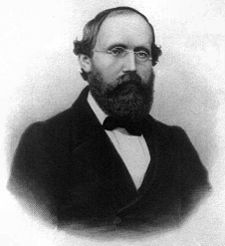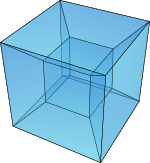Bernhard Riemann
2008/9 Schools Wikipedia Selection. Related subjects: Mathematics
| Bernhard Riemann | |
 Bernhard Riemann, 1863
|
|
| Born | September 17, 1826 Breselenz, Germany |
|---|---|
| Died | July 20, 1866 (aged 39) Selasca, Italy |
| Residence | |
| Citizenship | |
| Fields | Mathematician |
| Institutions | Georg-August University of Göttingen |
| Alma mater | Georg-August University of Göttingen Berlin University |
| Doctoral advisor | Carl Friedrich Gauss |
| Known for | Riemann Hypothesis Riemann Integral Elliptic geometry |
Georg Friedrich Bernhard Riemann (pronounced REE mahn or in IPA: ['ri:man]; September 17, 1826 – July 20, 1866) was a German mathematician who made important contributions to analysis and differential geometry, some of them paving the way for the later development of general relativity.
Biography
Early life
Riemann was born in Breselenz, a village near Dannenberg in the Kingdom of Hanover in what is today Germany. His father, Friedrich Bernhard Riemann, was a poor Lutheran pastor in Breselenz who fought in the Napoleonic Wars. His mother died before her children were grown. Riemann was the second of six children, shy, and suffered from numerous nervous breakdowns. Riemann exhibited exceptional mathematical skills, such as fantastic calculation abilities, from an early age, but suffered from timidity and a fear of speaking in public.
Middle life
In high school, Riemann studied the Bible intensively, but his mind often drifted back to mathematics. He even tried to prove mathematically the correctness of the Book of Genesis. His teachers were amazed by his genius and his ability to solve extremely complicated mathematical operations. He often outstripped his instructor's knowledge. In 1840, Riemann went to Hanover to live with his grandmother and attend lyceum (middle school). After the death of his grandmother in 1842, he attended high school at the Johanneum Lüneburg. In 1846, at the age of 19, he started studying philology and theology in order to become a priest and help with his family's finances.
In 1847, his father (Friedrich Riemann), after gathering enough money to send Riemann to university, allowed him to stop studying theology and start studying mathematics. He was sent to the renowned University of Göttingen, where he first met Carl Friedrich Gauss, and attended his lectures on the method of least squares.
In 1847, Riemann moved to Berlin, where Jacobi, Dirichlet, and Steiner were teaching. He stayed in Berlin for two years and returned to Göttingen in 1849.
Later life
Bernhard Riemann held his first lectures in 1854, which not only founded the field of Riemannian geometry but set the stage for Einstein's general relativity. In 1857, there was an attempt to promote Riemann to extraordinary professor status at the University of Göttingen. Although this attempt failed, it did result in Riemann finally being granted a regular salary. In 1859, following Dirichlet's death, he was promoted to head the mathematics department at Göttingen. He was also the first to propose the theory of higher dimensions, which greatly simplified the laws of physics. In 1862 he married Elise Koch and had a daughter. He died of tuberculosis on his third journey to Italy in Selasca (now a hamlet of Ghiffa on Lake Maggiore).
Influence
Riemann's published works opened up research areas combining analysis with geometry. These would subsequently become major parts of the theories of Riemannian geometry, algebraic geometry, and complex manifold theory. The theory of Riemann surfaces was elaborated by Felix Klein and particularly Adolf Hurwitz. This area of mathematics is part of the foundation of topology, and is still being applied in novel ways to mathematical physics.
Riemann made major contributions to real analysis. He defined the Riemann integral by means of Riemann sums, developed a theory of trigonometric series that are not Fourier series—a first step in generalized function theory—and studied the Riemann-Liouville differintegral.
He made some famous contributions to modern analytic number theory. In a single short paper (the only one he published on the subject of number theory), he introduced the Riemann zeta function and established its importance for understanding the distribution of prime numbers. He made a series of conjectures about properties of the zeta function, one of which is the well-known Riemann hypothesis.
He applied the Dirichlet principle from variational calculus to great effect; this was later seen to be a powerful heuristic rather than a rigorous method. Its justification took at least a generation. His work on monodromy and the hypergeometric function in the complex domain made a great impression, and established a basic way of working with functions by consideration only of their singularities.
Euclidean geometry versus Riemannian geometry
In 1853, Gauss asked his student Riemann to prepare a Habilitationsschrift on the foundations of geometry. Over many months, Riemann developed his theory of higher dimensions. When he finally delivered his lecture at Göttingen in 1854, the mathematical public received it with enthusiasm, and it is one of the most important works in geometry. It was titled Über die Hypothesen welche der Geometrie zu Grunde liegen (loosely: "On the foundations of geometry"; more precisely, "On the hypotheses which underlie geometry"), and was published in 1868.
The subject founded by this work is Riemannian geometry. Riemann found the correct way to extend into n dimensions the differential geometry of surfaces, which Gauss himself proved in his theorema egregium. The fundamental object is called the Riemann curvature tensor. For the surface case, this can be reduced to a number (scalar), positive, negative or zero; the non-zero and constant cases being models of the known non-Euclidean geometries.
Higher dimensions
Riemann's idea was to introduce a collection of numbers at every point in space that would describe how much it was bent or curved. Riemann found that in four spatial dimensions, one needs a collection of ten numbers at each point to describe the properties of a manifold, no matter how distorted it is. This is the famous metric tensor.
Writings in English
- 1868. "On the hypotheses which lie at the foundation of geometry" in Ewald, William B., ed., 1996. From Kant to Hilbert: A Source Book in the Foundations of Mathematics, 2 vols. Oxford Uni. Press: 652-61.
